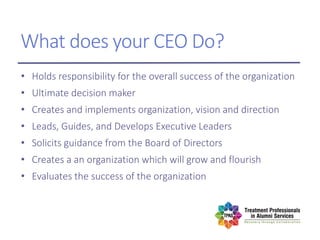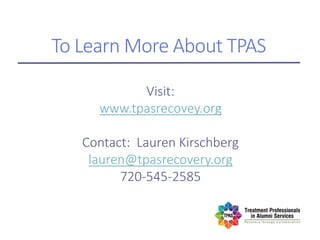Alumni & the ceo ppt final
- 1. Alumni & The CEO: TheBusinessCaseforaComprehensiveAlumniProgram Gina de Peralta Thorne, MS, TPAS Board Member Jim Geckler, CEO, Harmony Foundation, Inc.
- 2. OBJECTIVES: 1. Be able to explain how an alumni program can facilitate the move from acute-care model of addiction treatment to a focus on sustained recovery. 2. Be able to list which specific alumni services directly correlate with positive impact and enhanced alumni engagement. 3. Be able to describe the means by which an alumni program contributes to an increase in patient population.
- 3. Questions about Alumni Programs • How many of you have an alumni program? • What do you expect from your alumni program? • What do you hope for from building an alumni program? • What are the biggest challenges you see? • If you don’t have one, why not? • What holds you back? • Why are you here?
- 4. HISTORY OF ALUMNI PROGRAMS Peer Based Recovery Support Services (PB-RSS)
- 5. HISTORY OF ALUMNI PROGRAMS • In the mid-20th century- addiction treatment alumni associations came back into vogue during the rise of inpatient and residential treatment. • 1980’s – 1990’s as the treatment arena began more professionalized, these programs disappeared. • Treatment was dose specific, episodic and acute driven. Focus was more on treat the client/patient and move them to the next level of care. • Efforts to support the client long term after their treatment stay was left to other programs and services, (AA, NA, etc.)
- 6. Peer Based Recovery Support Services (Alumni Programs) TODAY: “Alumni Services serve as a vehicle for Post- Treatment Addiction Recovery Support, spearheaded by active members of the recovery community, many of whom are peer recovery coach specialists.” William White, Recovery White Paper 2013
- 7. Alumni Programs Provide: • Intentional Community • Education about Recovery • Support for people struggling • Life skills, navigating and enjoying the world in sobriety • Data for treatment outcomes • Referral potential • Brand visibility • Increased revenue for treatment organization .
- 8. Things You May Be Wondering About? • What Works? What are Best Practices? • Is alumni services necessary? • Where do I find the funds to support an alumni program? • What is the ROI for this organizational investment? • Is my leadership invested? • What skillset does an alumni coordinator need? • How do I integrate alumni programming into the rest of the tx program? • How do I retain talented staff?
- 9. TPAS Has the Answers
- 10. Treatment Professionals InAlumni Services (TPAS) Vision Supporting Recovery Champions Mission Foster dynamic collaboration among professionals seeking to improve outcomes for alumni and others in recovery Values Collaboration Community Innovation Integrity Passion Professionalism
- 11. TPAS Value Proposition • Building Intentional Community (locally, regionally and nationally) • Sharing ideas, resources and practices that effectively keep alumni engaged. • Mentoring & Coaching new Alumni Professionals about their role and how they can be most effective. • Assist treatment organizations generate revenue through growth in census. • Contribute to longer term recovery outcomes for alumni. • Bi-Annual Collaborative’s on East/West Coasts.
- 13. What is a Collaborative? • Launched in 2012- distinctly different from other addiction treatment industry conferences. • “Open Space Technology” - Agenda created by the participants – “real-time” - Participants are teachers and learners - Topics foster collaboration, promote community and connection.
- 14. Collaborative Data to Date • 11 Collaboratives since 2012 • 548 attendees representing national and international treatment and recovery community organizations. • Title Sponsor: Futures of Palm Beach • Sustaining Member: Hazelden Betty Ford • Charter Members A New Path, BRC Recovery, Cedar, Harmony Foundation, Inc., MAP, New Directions for Women , Northbound, Origins, Pavilion, Pine Grove, Valley Hope Association, Women in New Recovery
- 15. • Local, Regional and National alumni communities connecting together • Shift in thinking about collaboration in our industry • Statewide TPAS Chapter Groups • Unique opportunities for engagement • Private social media groups • Alumni connection giving back • Sober Fun events • Recovery coaching • Alumni Chapter Groups What was Born from the Collabortives?
- 17. Does TPAS Work?
- 18. How to Make Dollars and Sense of Dynamic Alumni Program Spring 2018 – gathered data in impact of alumni engagement. Focus: 1. Assess how participation in TPAS has impacted the field of alumni services. 2. Describe a distinctive model that fosters a unique learning environment for building community among addiction treatment service providers. 3. Propose suggestions for development of alumni service programs and a more professionalized role for alumni services personnel.
- 19. Outcomes TPAS Impact on Alumni Engagement Alumni Staff engaged with TPAS demonstrated: • The frequency of activities offered to Alumni increased • The type of activities offered to Alumni has diversified • Activities that pair Alumni with current center patients for sharing recovery stories increased • The number of Alumni returning to the center to participate in Alumni events increased.
- 20. Outcomes TPAS Impact on Organizations Survey respondents indicated a value proposition of Alumni Services contributions not only to the mission of long term recovery for clients, but also to the revenue generation for organizations. • Alumni referrals can account for as much as 50% of total referrals. • TPAS members reported that overall alumni referrals more than doubled since staff was involved in TPAS activities.
- 21. Outcomes: Cost Per Admission Survey respondents also indicated that cost per admission for an Alumni referral is substantially lower compared to traditional marketing and business development admissions: • Costs per Alumni admission range from $700 to $1100 • Costs per traditional marketing and business development activities range from $3500 to $5000 and even went as high as $8000 per referral in some instances.
- 22. Alumni Staff + Frequency of Alumni Events = Alumni Referrals
- 23. CEO Perspective Jim Geckler, CEO Harmony Foundation, Inc. Charter Member of TPAS
- 24. What does your CEO Do? • Holds responsibility for the overall success of the organization • Ultimate decision maker • Creates and implements organization, vision and direction • Leads, Guides, and Develops Executive Leaders • Solicits guidance from the Board of Directors • Creates a an organization which will grow and flourish • Evaluates the success of the organization
- 25. What is Your CEO Focused On? • People • Finance
- 26. OBJECTIVES: 1. Be able to explain how an alumni program can facilitate the move from acute-care model of addiction treatment to a focus on sustained recovery. 2. Be able to list which specific alumni services directly correlate with positive impact and enhanced alumni engagement. 3. Be able to describe the means by which an alumni program contributes to an increase in patient population.
- 27. OBJECTIVES: 1. Be able to explain how an alumni program can facilitate the move from acute-care model of addiction treatment to a focus on sustained recovery. 2. Be able to list which specific alumni services directly correlate with positive impact and enhanced alumni engagement. 3. Be able to describe the means by which an alumni program contributes to an increase in patient population.
- 28. Come Prepared • Know the objectives and address them first • Don’t shoot inward, know how your efforts will elevate the organization • Know your Goals • Know your ROI
- 29. Spring Collaborative April 14-17 Sandy Cove North East, Maryland www.tpasrecovery.org Coupon Code: winter50 ($50.00 off each registration)
- 31. To Learn More About TPAS Visit: www.tpasrecovey.org Contact: Lauren Kirschberg lauren@tpasrecovery.org 720-545-2585
Editor's Notes
- For more than 275 years, individuals and families recovering from severe alcohol and other drug problems have provided peer-based recovery support (P-BRS) to sustain one another and to help those still suffering. There is a long history of patient-led recovery mutual support organizations birthed within addiction treatment institutions in the United States. Some of the earliest of these include: 1. Ollapod Club (1868, New York State Inebriate Asylum) 2. The Godwin Association (1872, Franklin Reformatory Home for Inebriates) 3. Keeley Leagues (1891, Keeley Institutes)
- Today – Field of Addiction Treatment is flooding with new players who see us all competing for the same 10%. This has created a culture of what’s mine is mine. We don’t share, discuss or build bridges for effective resources. This idea of competition has weakened the success that we can provide to our families and clients with addiction. TPAS – has taken a different approach.
- Conducted focused data gathering on impact of Alumni engagement programs Spring 2018.
- Public speaking, represent the organization, reward and recognition
- Outcome slide is probably the most important






























